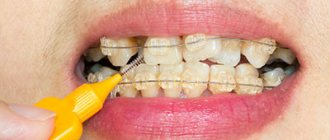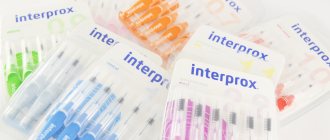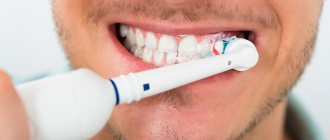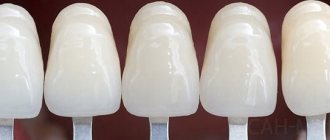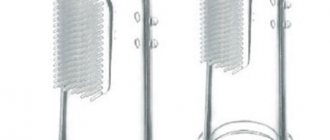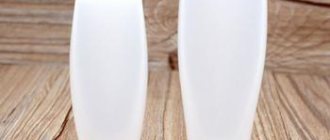Why does a child need mouthwash?
Mouthwash will become a reliable protector of children's teeth and gums. In combination with toothpaste, this product significantly reduces the risk of caries, stomatitis, gingivitis and other tissue inflammations.
Mouthwash can be a real lifesaver for children who suffer from problems such as:
- Difficulty brushing teeth . Many guys simply cannot reach their back teeth with a toothbrush or, due to their age, do not understand and are too lazy to brush them.
- Braces . With these plates, it is difficult for children to clean out all the leftover food, and caries begins to form under the braces. Rinsing allows you to further disinfect the oral cavity and, accordingly, reduce the risk of crown destruction and gum inflammation.
- Wounds. Children often injure the oral cavity, and even after baby teeth fall out, unpleasant sockets often remain in which bacteria accumulate. Regular rinsing will speed up healing and stop the inflammatory process.
In addition, mouthwashes with a pleasant taste and smell can become an incentive for your baby to take care of his oral health. It’s so joyful to rinse your mouth with a fresh solution with the aroma of mint or pine in the evening.
How to choose dental floss
Dental floss is another helpful tool if you need to brush your teeth after eating. Instead of using toothpicks found in all cafes and restaurants after lunch or dinner, it is better to use dental floss. A toothpick, due to its shape (a fairly thick base and a sharp tip), is not able to clean the crevices between the teeth, but at the same time it injures the gums. Dental floss is very thin, which allows it to penetrate between the teeth without contacting the gums. Let's figure out how to choose the right dental floss.
Dental floss varies in thickness and composition. In terms of thickness, choose thicker threads if you have large distances between your teeth and thin ones if there is crowding or your teeth are very tightly spaced. The thickness of the thread is always indicated on the packaging. Use waxed floss; it moves easier between your teeth and even makes a distinctive sound when your teeth are cleaned. If you wear braces, unwaxed floss is contraindicated because it will simply get tangled in the brackets.
Some manufacturers offer flavored dental floss, but mint or other flavors do not affect the quality of the floss in any way, so it is called a matter of taste. You can also choose dental floss fixed between two plastic holders. This option will make brushing your teeth easier and free up your other hand.
The main purpose of dental floss is to clean teeth in hard-to-reach places, thus preventing the accumulation of bacteria, the formation of plaque and tartar. Naturally, we do not have the opportunity to always take a toothbrush with us to carry out oral hygiene after every meal. This is not required - brushing your teeth with a brush and toothpaste twice a day is enough. But you need to get rid of food deposits on time. This is why it is recommended to carry dental floss with you. And now you know how to choose dental floss.
Rules for using mouthwashes for children
Young children are not recommended to use adult mouthwashes. Such products often contain elements harmful to fragile tissues. For example, triclosan affects not only harmful but also beneficial bacteria, and alcohol can dry out the mucous membrane to a painful state.
Before giving any, even the most harmless, rinse to a child, be sure to consult a specialist. Children's portions should be diluted with water in a 1:1 ratio.
It is also important to remember that rinsing cannot replace a thorough brushing of your teeth. Oral care should be comprehensive, and it should start with high-quality children's toothpaste.
An excellent means of cleaning teeth for children aged 4-8 years will be Asepta Kids fluoride-free gel toothpaste, developed taking into account the structural features of the tooth enamel of children at this age. The paste does not contain fluoride, parabens, sodium lauryl sulfate or antiseptics, and its natural components provide reliable protection against caries and inflammatory processes in the oral cavity. In addition, the procedure for brushing your baby’s teeth will be very pleasant, because all children adore the bright taste of tutti-frutti.
Kinds
To choose the right product, it is important to understand how and when it works best.
Stay up to date! There are four main types of rinse aids:
- Before cleaning . Designed to clearly demonstrate to the child which areas of the oral cavity he cleans the worst. Thanks to special reagents in its composition, it stains the areas of greatest accumulation of bacteria (plaque, cheeks, tongue, etc.). After this procedure, the baby will brush his teeth with more enthusiasm.
- After cleaning . A standard but effective means for high-quality cleaning of the oral cavity. It stops the reproduction and growth of pathogenic bacteria, eliminates bad breath and accelerates healing if mechanical damage to the mucous membrane has occurred.
- Against caries . Helps strengthen fragile tooth enamel, saturates it with fluoride and calcium, and inhibits the growth of cariogenic bacteria. Recommended for use in children prone to dental diseases or as an addition to the main treatment of caries.
- Plant based . A solution without dyes, sugar and aggressive chemical components. Freshen breath, suppress the growth of pathogenic microflora. Suitable for small children who may still swallow some liquid while brushing their teeth.
Folk recipes
By preparing a rinse for children themselves, parents will be confident in its composition and will not be afraid that they have chosen an overly aggressive product for the baby’s sensitive teeth and gums.
However, do not forget that home rinse cannot be stored for long. For example, brewed chamomile or mint can last in the refrigerator for up to 2-3 days. The solution must then be disposed of.
We will tell you about the most popular recipes for mouth rinses that are suitable for both adults and children.
Rose hip
Rosehip is an excellent mouthwash for children with various gum inflammations, such as stomatitis and gingivitis.
How to prepare a rinse: Take a handful of rose hips and pour 1 liter of boiling water. Place the mixture over medium heat and then bring to a boil. Then add five drops of peppermint essential oil.
How to use: It is recommended to rinse your mouth twice a day.
Oak bark
Oak bark in combination with other herbs will be an excellent anti-inflammatory agent. This tree has wound-healing and hemostatic properties. Gargles based on oak bark quickly relieve swelling and allergic reactions, eliminate bad breath and relieve toothache.
How to prepare a mouthwash: pour 2 tablespoons of oak bark into 1 cup of boiling water. Place the mixture in a water bath for 30 minutes, then cool and strain. At the same time, pour 1 glass of boiling water over 2 tablespoons of walnut leaves, and then 2 tablespoons of mint and sage into a glass of boiling water, leave to infuse for 20 minutes and strain.
At the end, mix all the ingredients and add 2 teaspoons of baking soda, a couple of drops of eucalyptus essential oil and tea tree oil to the rinse. The composition should be mixed well, then put in the refrigerator.
How to use: Rinse your mouth twice a day for a week.
Soda and iodine
If your child complains of a toothache, but a trip to the doctor is planned only for tomorrow, you should try rinsing your mouth with soda and iodine.
How to prepare a mouthwash: Dissolve 1 teaspoon of baking soda in a glass of water and add a few drops of iodine.
How to use: Rinse your mouth once an hour. Attention! The use of soda and iodine in the treatment of toothache is permissible only in children over 8 years of age.
Mint and rosemary
For inflammation of the gums, it is very useful to use a rinse with mint and rosemary.
How to prepare a rinse: Boil three glasses of water, and then add 1 teaspoon of rosemary and mint, as well as a spoon of anise seeds. This mixture also needs to be boiled for 10 minutes and then filtered.
How to use: Rinse your mouth twice a day.
Tea tree oil
Gargling with tea tree oil will help eliminate bad breath, prevent childhood tooth decay, and relieve gum disease.
How to make a mouthwash: Add 3 drops of tea tree oil to a glass of water. How to use: Rinse your mouth with the solution once a day, before going to bed.
Chamomile decoction
Chamomile decoction is an excellent soothing and anti-inflammatory remedy for gums. It is this pharmaceutical flower that dentists advise patients with gingivitis, stomatitis and increased sensitivity of teeth.
How to prepare a rinse: 2 tablespoons of dried chamomile flowers should be poured with 0.5 liters of warm water. Boil the resulting mixture thoroughly, then strain through cheesecloth and cool to room temperature.
How to use: When the mixture has cooled, rinse your mouth with it at least three times a day.
Sage decoction
Since the time of Catherine the Great, sage has been an effective remedy for both toothache and acute inflammation of the gums.
How to prepare a mouthwash: pour 1 tablespoon of sage flowers into a glass of cold water. Bring the mixture to a boil, keep on fire for 5-7 minutes and remove. Cool the broth, strain through a fine sieve or cheesecloth.
How to use: Once the broth has cooled, you can give your child to rinse his mouth with it 3-5 times a day.
Propolis
Propolis has a pronounced antiseptic and anti-inflammatory effect, however, this remedy is used only for children over 4 years of age after consultation with a dentist and pediatrician.
How to prepare a rinse: Buy propolis tincture at the pharmacy, dissolve a teaspoon of tincture in a glass of water.
How to use: Rinse your mouth 3 times a day.
Sorrel
Summer juicy sorrel leaves are suitable not only for fresh soup, but also for the treatment of inflammation of the oral cavity. In addition, sorrel improves blood circulation in the gums.
How to prepare a rinse: Boil 1-2 tablespoons of sorrel, cool and let the mixture sit for a couple of hours.
How to use: Rinse the inflamed mouth until the condition of the gums improves.
Kefir
Surprisingly, this fermented milk product helps with tissue inflammation and dental plaque. Kefir effectively loosens gums and stops the inflammatory process.
How to prepare a rinse: To create a baby rinse, it is important to take stale “ten-day” kefir, and then dilute half a glass of the drink 1:1 with warm boiled water.
How to use: Rinse your mouth throughout the day.
St. John's wort
Solar St. John's wort perfectly strengthens and heals the gums, effectively fights inflammation and slightly anesthetizes the tissue.
How to prepare a rinse: Pour 200 g of boiling water over a spoon of St. John's wort herb, then leave for 40 minutes and strain.
How to use: Rinse your mouth 2-3 times a day.
How to apply it correctly?
For your information! It is necessary to accustom a child to rinsing the mouth without subsequent swallowing from an early age, optimally from two years of age.
Unfortunately, there is no decent industrial product for such babies, so you can use regular filtered water or chamomile decoction.
Explain to your baby that the liquid should roll around the mouth , passing between the teeth.
Demonstrate the movements by blowing air into your cheeks .
Starting from the age of 6, you can already trust the child to take care of the condition of the oral cavity independently , but still under close supervision from adults.
The sequence of actions should be as follows:
- Brushing teeth with paste. Let the child squeeze out the paste himself. Show that a pea-sized amount of product is enough for complete cleaning. Explain how to move the brush correctly to get rid of dirt. The optimal time for the procedure is 1.5 – 2 minutes. When finished, spit out the toothpaste and rinse your mouth with water.
- Using rinse aid . To determine the dosage, look at the back wall of the bottle - as a rule, all the necessary information is indicated there. In addition, most modern rinses are equipped with a special lid with a measuring machine. Do not allow your baby to swallow a mouthful of solution - this will increase the risk of swallowing. You need to rinse your mouth for 1-2 minutes, then spit the liquid into the sink.
Important! Starting from the age of 14, a teenager has the right to switch to adult mouthwashes, but in a smaller dosage (1/3 less).
Precautionary measures
If you use mouthwashes that contain alcohol, switch to alcohol-free formulations. If, for reasons of your dental health, you need to use alcohol-containing or medicated rinses produced by prescription with a high concentration of active substances, store them out of the reach of children. This measure will prevent poisoning. For a child weighing 12 kg, a dose of 150-300 ml of rinse aid can be lethal.
Be alert for signs of alcohol or fluoride poisoning. Signs of alcohol poisoning: irritability, a strong drop in blood sugar (hypoglycemia) as a result of the binding of glucose by alcohols, loss of consciousness, lethargy and convulsions. Signs of fluoride poisoning include shallow breathing, nausea, vomiting, diarrhea, abdominal pain, shock, hand tremors and convulsions. If your child has these symptoms, call a poison control center or 911 immediately.
Availability of products and their prices
[google]
Baby mouthwashes come in flavors that kids like: bubble gum, cinnamon, berry, mint, or citrus.
Rinse aids for children are sold in supermarkets, pharmacies, and stores. Their average cost ranges from 120 to 150 rubles.
The most popular mouthwashes for children contain fluoride to prevent tooth decay. For example, Oral-B Anti-Cavity Rinse and ACT for Kids have received approval from the American Dental Association (ADA). Listerine, Dr. Fresh and Vi-Jon are other popular brands that offer pre- and post-brushing rinses for children.
Mouthwash composition
Depending on the type of rinse aid, it may contain different components. However, the basic elements remain the same:
- Fluorine. This element is necessary to strengthen tooth enamel, it helps to avoid caries, and reduces the risk of developing increased abrasion and sensitivity. In modern liquids, manufacturers use a progressive component - amino fluoride. The amount of fluoride may vary, so it is recommended to take the option that your dentist recommends. Operating principle: after using the product, a protective film is formed on the enamel, from which fluoride gradually penetrates into the surface of the tooth over a couple of hours.
- Antiseptics. The liquid may contain: chlorhexidine, cetylpyridinium chloride, triclosan and some others. They prevent the active proliferation of bacterial agents in the mouth. Therefore, the rinse helps prevent gingivitis, stomatitis, and treat periodontitis. You can use antiseptic products without harm for 2-3 weeks.
- Alcohol. Included in most brands. It is the best preservative and solvent, but its percentage composition may vary. When choosing a product for a child, you need to pay special attention to this point and purchase an alcohol-free mouth rinse.
- Xylitol. A substance with a sweet taste, but unlike regular sugar, it strengthens enamel and reduces the risk of developing caries.
- Plant extracts. Usually, extracts of medicinal plants are added that have anti-inflammatory, soothing, strengthening, and restorative effects. You need to carefully read the composition and make sure that you are not allergic to herbal ingredients.

